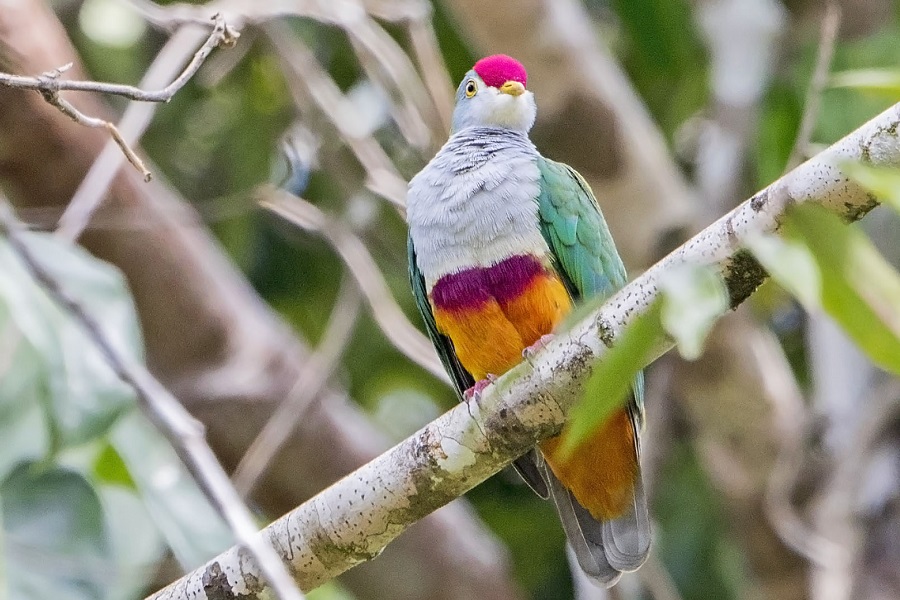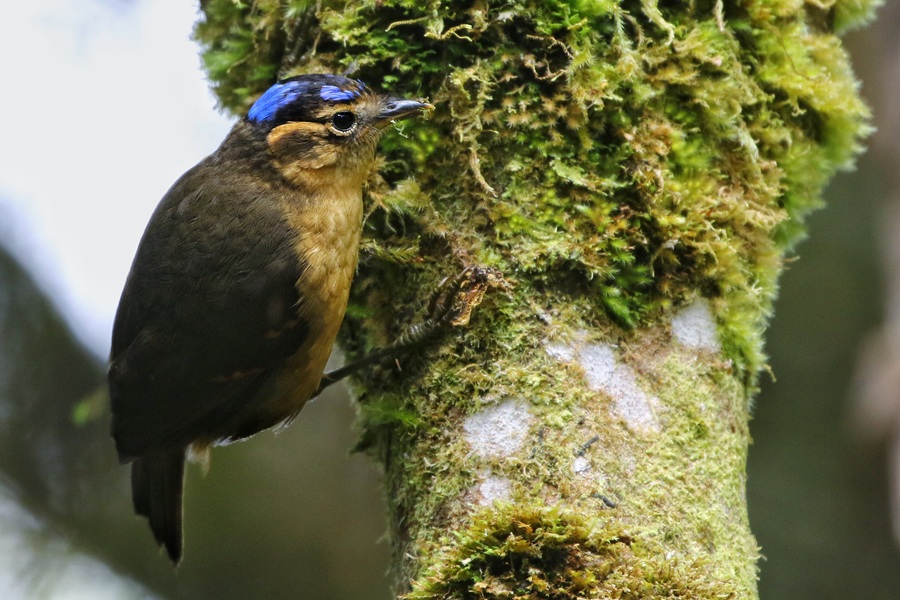Papua New Guinea: Highlights
In this shortened version of our classic PNG: Mainland birding tour, over the course of just twelve days we can offer many of the most phenomenal birds found here at a significantly reduced cost. This tour features an excellent chance at seeing all seven endemic bird families, plus more than fifteen dazzling bird-of-paradise species. Standout birds along the route include Pheasant Pigeon, Sclater's Crowned Pigeon, New Guinea Flightless Rail, Brehm's Tiger Parrot, Little Paradise Kingfisher, Spangled Owlet-nightjar, Blue-capped Ifrit, Wattled Ploughbill, Chestnut-backed Jewel-babbler, Greater Bird-of-paradise, Blue Bird-of-paradise, Ribbon-tailed Astrapia, Crested Satinbird, Flame Bowerbird, and more! A truly superb selection of the region's best birds in less than two weeks.
Next Dates
22 June - 3 July 2026 (12 days)
Leaders:
Donna Belder
Group Size Limit:
7
Single Room Supplement: $
1500 USD
Deposit: $
1500 USD
Price: $
8500 USD
Add a Title
Leaders:
Donna Belder
Group Size Limit:
Add a Title
Single Room Supplement: $
TBD
Deposit: $
TBD
Price: $
TBD
Add a Title
9 July - 20 July 2028 (12 days)
Leaders:
Joachim Bertrands
Group Size Limit:
7
Single Room Supplement: $
1500 USD
Deposit: $
1500 USD
Price: $
8500 USD
Add a Title
Leaders:
Joachim Bertrands
Group Size Limit:
Add a Title
Single Room Supplement: $
TBD
Deposit: $
TBD
Price: $
TBD
Add a Title
In recent years, Papua New Guinea's domestic flight network has become extremely unreliable. Our main tour has been designed with a charter flight from Kiunga to Mount Hagen, so it is unlikely that birding will be majorly affected by any flight delays.
Accommodation:
Excellent hotels in Port Moresby and around Mount Hagen. Comfortable hotels in Kiunga. Very basic guesthouse with shared rooms, facilities and cold water for our two nights up the Fly River (uncomfortable, but necessary for some of the best lowland birding and spotlighting in New Guinea!).
Walking difficulty:
To fully participate in this tour, participants should be able to keep balance and walk comfortably at a birding pace on muddy/uneven/steep trails for at least an hour. We also welcome any participants who feel they might not quite be at this level of fitness, but caution there will be one or two birding sessions which you might choose to skip. Please email us if you are unsure or want more details.
Tour cost includes:
All accommodation, main meals, drinking water, internal flights (as stated in itinerary), overland transport, tips to local drivers and guides, travel permits, entrance fees, and guide fees.
Tour cost excludes:
Flights before and after the tour start/end, visa, travel insurance, tips to tour leaders, laundry, drinks, and other items of a personal nature.


NOTE: We will not be running this tour in 2027, to avoid possible complications with the Papua New Guinea elections, which usually bring about short-term riots in Mount Hagen. The next scheduled departure will be in 2028.
This is the short version of our Papua New Guinea: Mainland tour. For those who wish to see the longer and more comprehensive itinerary, click here!
Day 1: After early arrivals into Port Moresby International Airport (POM), we will drop our bags at the hotel and head straight out to the famous Varirata National Park, where we will be birding for the rest of the day. Sneaky Growling Riflebirds and Crinkle-collared Manucodes move through the canopy, and we will search for beautiful Brown-headed Paradise Kingfisher, the skulking Chestnut-backed Jewel-babbler, a huge assortment of pigeons and honeyeaters, as well as many other exciting birds like Black-billed Brushturkey, Barred Owlet-nightjar, Rufous-bellied Kookaburra, Wallace’s Fairywren, Goldenface, White-bellied Whistler, the poisonous Hooded Pitohui, Hooded Butcherbird, Chestnut-bellied Fantail, and Golden Monarch. We may see our first of New Guinea’s unique endemic families here, with both Black Berrypecker and Dwarf Longbill regularly encountered. Night in Port Moresby.
Day 2: We will take a morning flight to Kiunga, and then our afternoon will be spent at the famous “KM17”, where the Greater Bird-of-paradise scenes were filmed for David Attenborough’s “Life of Birds” documentary. The birds have since moved a few trees over, but still put on a great show whenever the females pop by! We will have our first chance to see the tiny King Bird-of-paradise here, as well as both Papuan and Hooded Pittas. We might also come across the rare Wallace’s Owlet-nightjar and bubbling Marbled Frogmouth after dark. Night at Kiunga.
Day 3-4-5: Our two-night/three-day boat trip up the mighty Fly River is always the most exciting section of this tour, with the next two nights at a basic guesthouse in the forest before we return to our Kiunga hotel late on Day 5 for much-needed showers! Due to an excellent ecotourism program, the forest lining the Elevala River tributary where we will be based is protected and full of birds. Huge trees dangle their vegetation into the water and footprints on muddy banks often betray the presence of unseen Southern Cassowaries. There is a huge number of species to look for here, but among the most spectacular are Sclater’s Crowned Pigeon (usually found eyeing us cautiously from a conspicuous perch in the early morning), Twelve-wired Bird-of-paradise (typically calling loudly from his display pole visible from our guesthouse balcony), and the glowing Flame Bowerbird (with luck, our local guides will have found a bower for us to stake out). Other mega birds include New Guinea Flightless Rail, Spangled Owlet-nightjar, Papuan Hawk-Owl, Hook-billed Kingfisher, Little Paradise Kingfisher, Blue Jewel-babbler, and Campbell’s Fairywren. More common species include Lowland Peltops, Large Fig Parrot, Golden Myna, White-bellied Pitohui, Papuan Babbler, Long-billed Cuckoo, many more parrots and pigeons, plus the occasional Long-tailed Honey Buzzard, Pesquet’s Parrot, or Obscure Honeyeater.
Day 6: Our last morning at Kiunga will focus on the accessible roadside forests closer to town in search of some new species. We will likely be spending time at a forested overlook on Boystown Road, where Emperor Fairywren is often seen, or scanning some fields for the endemic White-spotted Mannikin. Towards the middle of the day, we fly to the highland city of Mount Hagen (using a charter flight, since this route is notoriously unreliable on commercial tickets).
After transferring to the homely Kumul Lodge, we will be immediately greeted by Ribbon-tailed Astrapias on the feeding table, alongside Belford’s Melidectes, Brehm’s Tiger Parrot, and Common Smoky Honeyeater. The surrounding gardens are regularly visited by the unique Crested Satinbird, noisy Blue-capped Ifrit, and beautiful Eastern Crested Berrypecker, all of these representing endemic bird families found only in New Guinea! Other species here include Forbes’s Forest Rail, Feline and Mountain Owlet-nightjars, Archbold’s Nightjar, New Guinea Woodcock, White-winged Robin, Mountain Firetail, and Rusty-naped Bellbird (closely related to the Crested Bellbird of Australia!). Night at Kumul Lodge.
Day 7-8-9: Visiting several sites in the vicinity of the lodge, we will be astounded by the luminous Blue Bird-of-paradise, otherworldly King-of-Saxony Bird-of-paradise, and immense Brown Sicklebill, three of the most exciting “BoPs” of the highlands! We should also see other good-looking birds such as Greater Lophorina, Tit Berrypecker, Ornate Melidectes, Black-breasted Boatbill, Regent Whistler, Plum-faced Lorikeet, Orange-billed Lorikeet, plus a large assortment of interesting small birds like Mountain Mouse-warbler and Brown-breasted Gerygone. In some drier habitat, we will look for Yellow-breasted Bowerbird, Black-headed Whistler, Mountain Honeyeater, and Papuan Grassbird, then check some cascades for the strange Torrent Flyrobin. We will work hard to entice the skulking Lesser Melampitta into view, spot a flightly Mottled Berryhunter in the midcanopy, and track down high-pitched calls of the male Wattled Ploughbill - these three birds representing the remaining endemic bird families. There is of course the usual assortment of robins, whistlers, honeyeaters, pigeons, and scrubwrens to also look for in this very diverse area! Nights at Kumul Lodge.
Day 10: After a final morning at Kumul, which might allow us to target Princess Stephanie's Astrapia or Short-tailed Paradigalla if these are available, we will head back to Mount Hagen for a flight returning us to Port Moresby for overnight.
Day 11: Another day at Varirata, this time we will arrive at dawn to watch the flamboyant Raggiana Birds-of-paradise at their display tree – with luck, some females will drop by and send the males into a frenzy of display! We will build on our species list from Day 1 of the tour, possibly adding some trickier species like Painted Quail-thrush or Forest Bittern.
Day 12: The tour ends this morning with departures from Port Moresby International Airport (POM).
NOTE: We are also able to arrange a four night extension to Walindi on the island of New Britain upon request. This could be escorted either by the Ornis leader, or a competent lodge bird guide from Walindi Resort. This would follow the itinerary of our usual extension for Papua New Guinea: Islands.



































